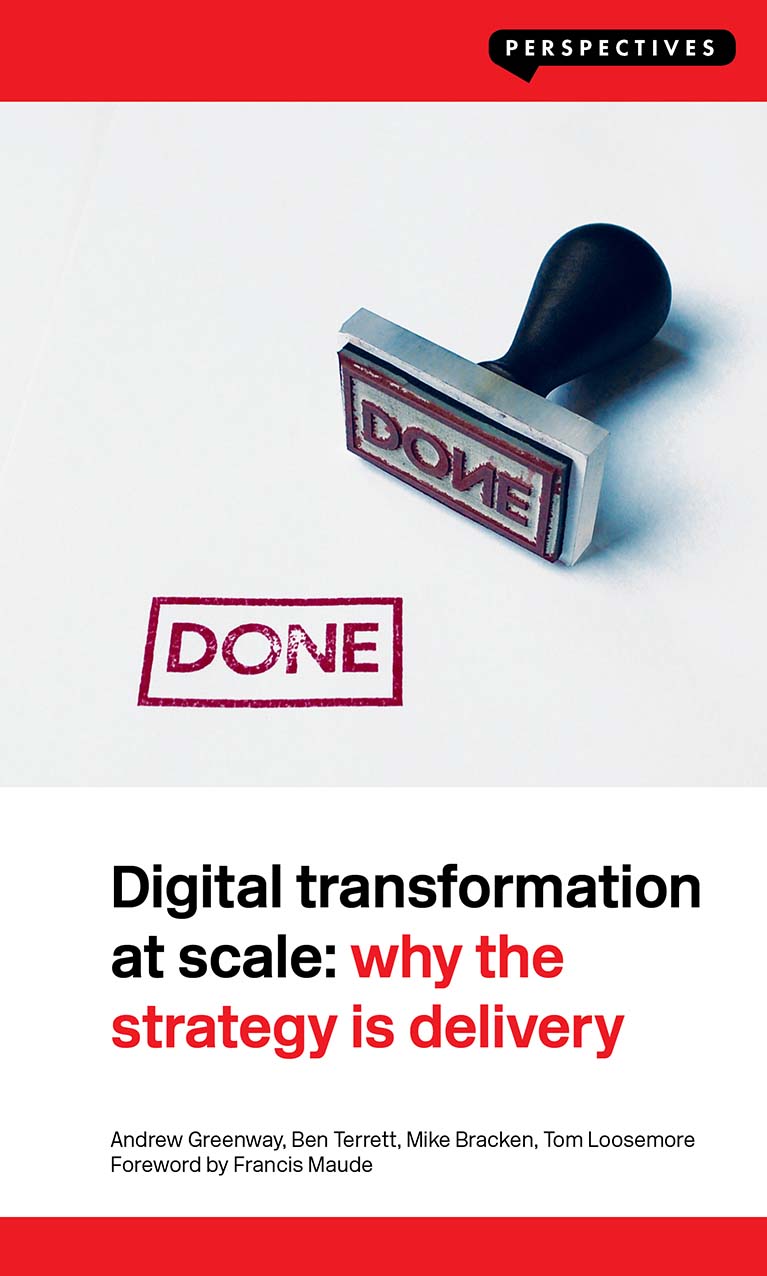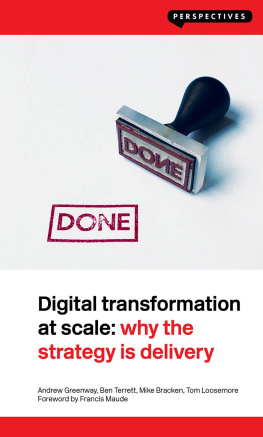Bracken Mike - Digital Transformation at Scale: Why the Strategy Is Delivery
Here you can read online Bracken Mike - Digital Transformation at Scale: Why the Strategy Is Delivery full text of the book (entire story) in english for free. Download pdf and epub, get meaning, cover and reviews about this ebook. City: London, year: 2018, publisher: Book Network Intl Limited trading as NBN International (NBNi);London Publishing Partnership, genre: Politics. Description of the work, (preface) as well as reviews are available. Best literature library LitArk.com created for fans of good reading and offers a wide selection of genres:
Romance novel
Science fiction
Adventure
Detective
Science
History
Home and family
Prose
Art
Politics
Computer
Non-fiction
Religion
Business
Children
Humor
Choose a favorite category and find really read worthwhile books. Enjoy immersion in the world of imagination, feel the emotions of the characters or learn something new for yourself, make an fascinating discovery.
- Book:Digital Transformation at Scale: Why the Strategy Is Delivery
- Author:
- Publisher:Book Network Intl Limited trading as NBN International (NBNi);London Publishing Partnership
- Genre:
- Year:2018
- City:London
- Rating:4 / 5
- Favourites:Add to favourites
- Your mark:
- 80
- 1
- 2
- 3
- 4
- 5
Digital Transformation at Scale: Why the Strategy Is Delivery: summary, description and annotation
We offer to read an annotation, description, summary or preface (depends on what the author of the book "Digital Transformation at Scale: Why the Strategy Is Delivery" wrote himself). If you haven't found the necessary information about the book — write in the comments, we will try to find it.
Bracken Mike: author's other books
Who wrote Digital Transformation at Scale: Why the Strategy Is Delivery? Find out the surname, the name of the author of the book and a list of all author's works by series.
Digital Transformation at Scale: Why the Strategy Is Delivery — read online for free the complete book (whole text) full work
Below is the text of the book, divided by pages. System saving the place of the last page read, allows you to conveniently read the book "Digital Transformation at Scale: Why the Strategy Is Delivery" online for free, without having to search again every time where you left off. Put a bookmark, and you can go to the page where you finished reading at any time.
Font size:
Interval:
Bookmark:

Copyright 2018 Andrew Greenway, Ben Terrett, Mike Bracken and Tom Loosemore
Published by London Publishing Partnership www.londonpublishingpartnership.co.uk
Published in association with Enlightenment Economics www.enlightenmenteconomics.com
All the images in the colour plates section are courtesy of Ben Terrett or @gdsteam Flickr and are published under a Creative Commons License
All Rights Reserved
ISBN: 978-1-907994-80-7 (ebk)
A catalogue record for this book is available from the British Library
This book has been composed in Candara
Copy-edited and typeset by T & T Productions Ltd, London www.tandtproductions.com
Foreword
F rancis: if plagiarism is the sincerest form of flattery, you should be feeling very flattered.
This email dropped into my inbox in early 2015. It was from Malcolm Turnbull, Australias prime minister at the time of writing but then the communications minister. It referred to his recent establishment of the Digital Transformation Office, Australias equivalent of Britains Government Digital Service (GDS), and explicitly modelled on what we had created in the UK. This followed President Obamas creation of a US Digital Service, copied from the same template.
In the lead up to the 2010 general election, I was leading the Conservative Partys work in opposition on preparation for government. Britain faced a growing fiscal crisis with a budget deficit of over 11% of GDP. At the same time, the UK had become a byword round the world for costly government IT car crashes. There had to be a better way.
I wanted to ensure that the UK could be the most digital government in the world. That didnt mean that it was enough to be able to download a form from the web, print it, fill it in by hand and return it by post. It meant the state offering services built around the needs of the user. I commissioned Martha Lane Fox to make recommendations on how we should proceed: to make government services that could be done online, be done properly online digital by default. The rest is history. A single web domain for the British government, GOV.UK, replaced hundreds of separate websites. Scores of government transactions became digital by default. People who wouldnt have dreamed of working in government signed up for the ride, proud to become public servants. In 2016 the UN ranked the UK first in the world for digital government.
Along the way, we learned about what you need to do to make difficult disruptive change happen in government. Some of it would seem obvious to anyone experienced in turning around businesses that have lost their way. Cumulatively, our efficiency programme saved over 50 billion in five years, mostly from the running costs of government. None of it was easy, and there is much more to do.
I am very proud of what the UK started. I hope this book inspires others to do the same.
Francis Maude
The Rt Hon. the Lord Maude of Horsham
March 2018
Prologue
W hat you are about to read may strike you as obvious.
Governments and big businesses have a habit of confusing complexity with substance. This is especially true when technology is introduced into the conversation. Large organisations have grown used to the idea that their world is uniquely complicated and special. The technology, processes and business models they use match this perception of their reality.
Yet the more layers one adds to an organisation, the shakier it becomes. A lot of big organisations have to work on things that are new or complex, and there is no escaping that. However, often they are doing things that have been attempted many times before. On these occasions, being capable of holding together something very complex can become a hindrance. Some people can hold a crumbling structure together long past its natural life.
We all end up counting the cost of complexity taken too far. This includes the UK government. In September 2011, it scrapped the NHS National Programme for IT. The 12 billion project was the biggest civilian IT project of its kind anywhere ever, for an organisation with the largest workforce in Europe. Its difficult to imagine a much more complex challenge. Most of the money had gone straight down the drain. It was expensive and embarrassing. The failure was both political and technical. Worse, the NHS programme wasnt unusual. The UKs first e-Borders scheme, started in 2003 in order to collect and analyse data on everyone travelling to and from the UK, was cancelled after 11 years and an 830 million investment, leaving behind highly manual and inefficient systems. Rumours of a Millionaires Club, admitting contractors who had pocketed seven-figure sums, swirled around the doomed borders programme.
In response to this litany of IT troubles, the UK launched the Government Digital Service in 2011. The GDS was a new institution made responsible for the digital transformation of government, designing public services for the internet era. It snipped 4 billion off the governments technology bill, opened up public sector contracts to thousands of new suppliers, and delivered online services so good that citizens chose to use them over the offline alternatives, without a big marketing campaign. Other countries, and private sector companies too, took note.
Faced with the digital revolution, many people working in large organisations instinctively see its consequences as another layer of complexity. To some of them, digital promises a better fax machine, a quicker horse, a brighter candle. In fact, digital is about applying the culture, practices, business models and technologies of the internet era to respond to peoples raised expectations. It is not a new function. It is not even a new way of running the existing functions of an organisation, whether those are IT or communications. It is a new way of running organisations. A successful digital transformation makes it possible not only to deliver products and services that are simpler, cheaper and better, but for the organisation as a whole to operate effectively in the online era. As a GDS veteran wrote, digital institutions are those that are open, responsive and effective, led by people who have at least a basic level of digital competence, curiosity and confidence.
This book is best thought of as a set of guides for how to build a digital institution. It will explain how a growing band of reformers in businesses and governments around the world have helped their organisations pivot to this new way of working, and what lessons others can learn from their experience.
This is not the story of GDS. Hundreds of brilliant people contributed to digitising public institutions in the UK. Many of them didnt work in GDS, or even for the government. Thousands more have contributed to similar efforts in other countries. No book has the space to give them the credit they merit. We havent named names here (other than in a handful of direct quotations) because that would have meant leaving deserving people out. This book also uses an inclusive we throughout. Sometimes decisions at GDS were made by a leadership team or a product team, sometimes by individuals or by a collective. To those who should get a mention, we can only say sorry. Thank you to everyone who worked to make government simpler, cheaper and faster. You know who you are.
What follows draws on the UK government experience, but it doesnt cover everything that happened there. There are many stories from that time that others can tell better than we can. For example, there is not a lot in this book about how digital teams working in departments and agencies went about transforming several of the countrys biggest public services. There is little about the quiet political conversations in the background that kept the wheels turning. There is a whole book to be written about how GDS changed the relationship between the state and its technology suppliers, and brought open standards to the forefront of how officials thought about delivering services.
Font size:
Interval:
Bookmark:
Similar books «Digital Transformation at Scale: Why the Strategy Is Delivery»
Look at similar books to Digital Transformation at Scale: Why the Strategy Is Delivery. We have selected literature similar in name and meaning in the hope of providing readers with more options to find new, interesting, not yet read works.
Discussion, reviews of the book Digital Transformation at Scale: Why the Strategy Is Delivery and just readers' own opinions. Leave your comments, write what you think about the work, its meaning or the main characters. Specify what exactly you liked and what you didn't like, and why you think so.








